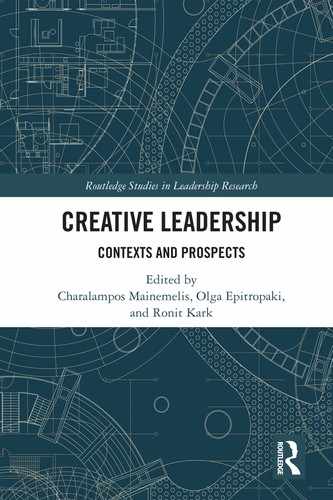Preface
Seven years ago, a series of stimulating conversations propelled us to defamiliarize a familiar question: What do creative leaders do? The question appeared embarrassingly simple, considering that the three of us have devoted our academic careers to researching and teaching creativity and leadership. It turns out, however, that we found it hard to come up with a mutually agreed concise answer. What made the task of answering the question difficult was not the shortage of knowledge but the profusion of it. We realized that far beyond our shared knowledge base on the subject, each one of us had accessed in the past additional reservoirs of scientific knowledge that the other two were, at best, only mildly familiar with. We eventually reached the conclusion that creative leadership was the focus of investigation of a large number of research streams—larger than what each one of us had initially thought—and that most of those streams had rarely engaged with one another in any form of intellectual exchange.
Upon reflecting on the distinctive properties of these research streams and on the potential benefits of pulling their knowledge stocks together, we submitted an article proposal to the Academy of Management Annals, with the stated purpose of developing a unified framework of creative leadership. An anonymous reviewer commented, “Overall, my core concern is that you are proposing a review for a literature that really doesn’t exist to any significant degree.” We replied by providing a sample list of 100 recently published articles on creative leadership, noting that this was just a subset of the body of research that we were going to examine. In the final article, we reviewed over 200 scholarly works culled from over 60 academic journals. By the time the article was published, we were certain that any researcher who had examined in-depth the link between creativity and leadership would be intimately familiar with at least one-third of these works. At the same time, we now had more and more solid reasons to believe that even researchers who were considered experts in their respective research streams might have never read (or even heard of) other clusters of articles included in this body of research.
Our article, which was a finalist for the Academy of Management Annals 2015 Best Article Award, was the first attempt to connect the dispersed and fragmented body of research on creative leadership. We believe that the multi-context framework that we proposed offers a fertile conceptual springboard for crafting more nuanced theories and empirical studies of creative leadership in the future. What is more important to the field, however, is not the framework itself, but the underlying motivation to connect distal research streams.
The purpose of this volume is to build upon this recent metatheoretical framework in order to foster the cross-fertilization of knowledge and insight among different research strands of creative leadership. The chapters in this book are authored by scholars who have made in the past outstanding contributions to research on creative leadership in their respective streams, or/and are currently conducting novel and interesting research in the area. By bringing together in this volume exemplar contributions from diverse bodies of scientific work, we seek to trigger fertile exchanges and recombinations of knowledge about creative leadership. We feel that the time is ripe for such a scholarly endeavor, considering that research on creative leadership is rapidly growing and the practice of creative leadership is spreading and gaining in importance across different types of organizational contexts.
Charalampos Mainemelis, Olga Epitropaki, and Ronit Kark
